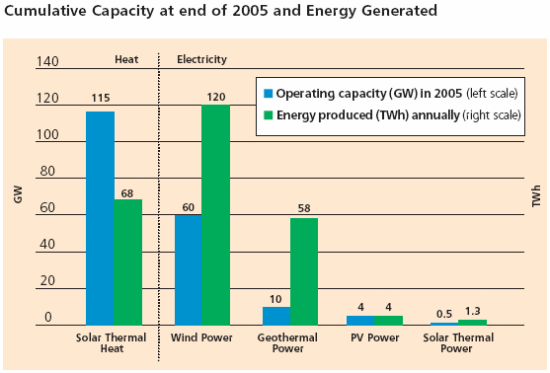As an Energy Source
Until recently, solar thermal installations were measured in square meters of installed collector area instead of their energy output. As a result, solar thermal was often excluded from official renewable energy statistics. Using a standard conversion factor of 0.7 kWth per m2 of collector area developed by the SHC Programme and solar trade associations, it is now possible to compare solar thermal with other energy sources.
Solar, compared with other renewable energy sources, is second only to wind in meeting the global energy demand. The annual energy produced TWh and the cumulative capacity (GW) at the end of 2005 for solar heating, wind, geothermal, photovoltaics and solar thermal power stations is shown in the graph.

As a Technology
Solar technologies can supply the energy for all of a building’s needs—heating, cooling, hot water, light and electricity—without the harmful effects of greenhouse gas emissions created by fossil fuels.
And, solar applications can be used almost anywhere in the world and are appropriate for all building types—
-
single-family homes,
-
multi-family residences,
-
office and industrial buildings,
-
schools,
-
hospitals,
-
and other public buildings
In the agriculture sector, solar technology is being used to dry crops ranging from coffee and tea to wool and chicken manure. Companies in Europe, North America, and numerous developing
countries see this technology as a cost-effective and environmentally sensitive process.
The majority of the energy used in commercial and industrial processes is below 250°C, a temperature range well suited for solar technologies. Solar technologies are being used for specific industrial processes, such as food processing, textile cleaning and drying, pharmaceutical and biochemical processes, desalination, and heating and cooling of factories.